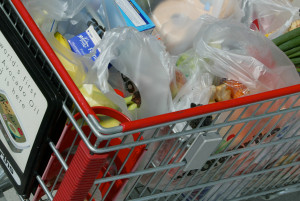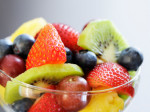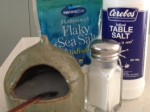 Over the past 50 years our diet has moved away from being based on the ‘real food’ we grow and cook ourselves to being one which is more dependent on the use of some processed foods and also eating more of our meals away from home.
Over the past 50 years our diet has moved away from being based on the ‘real food’ we grow and cook ourselves to being one which is more dependent on the use of some processed foods and also eating more of our meals away from home.
Many people believe we have lost the art of cooking. 1
Compared to ‘real food’ our present, more highly processed, diet has less dietary fibre, fewer micronutrients and is higher in additives, sugar, salt and calories. 1
Alongside these dietary changes advancements in mechanisation and technology has also meant a more sedentary lifestyle with less exercise.
Many research studies have concluded that these environmental factors have combined to increase the incidence of non-communicable diseases, such as cardiovascular disease, obesity, diabetes, metabolic syndrome etc, around the world.1
Food producers
It is tempting to lay some of the blame for poorer health at the door of the food industry however they are simply responding to consumer demand.
While food manufacturers could always do more to lower salt and sugar levels in our foods a recent study of nine food items found that between 2003-2013 food manufacturer’s had reduced the salt content in breakfast cereal by 28%; canned spaghetti by 15% and breads by 15%.2 One could also argue that there has never been a wider range of low energy, low-fat, salt and sugar items available for the consumer to choose from than there is today.
While people may express concern about the use of food additives to prolong the shelf life of foods we must remember that the additives of earlier times may have been cockroaches and weevils. We expect our food today to be fresh and available all year round and mostly it is.
The most important issue today is food safety, the availability of our food supply and it’s security.
Food safety
If we choose a lifestyle where others grow and process our food can we be sure that it is still safe to eat?
Here in New Zealand there is very robust legislation that governs our food supply:
- The Ministry of Primary Industry (MPI) protects our food from biological risk; governs productivity; resource sustainability and sets standards for exporters. 3
- The Ministry of Agriculture and Forestry is responsible for the biosecurity of plants and animals entering and leaving NZ. They are also concerned with animal welfare and along with the Ministry of Fisheries were amalgamated under the MPI organisation in 2010. 3
- The MPI also cover food security through the Australian and New Zealand Food Standards Authority (ANZFSA). This bi-national government agency covers food standards, consumer information and food science. It interprets and enforces codes that govern food labelling, additives, genetic modification issues etc. 3
- Organic foods do not have specific legislation governing certification. However all commercial producers in NZ are subject to requirements of the Fair Trading Act which covers misleading behaviour. Also a number of standards are used including Demeter International, IFOAM and Biogrow to keep food quality high.
Buyer beware
While the government can impose legislation regarding food production and supply it is the consumer who ultimately makes the decision about what they are prepared to swallow.
As with all things purchased the ‘buyer beware’ rule applies. However for this to work well when applied to our food chain we need to have readily available nutrition information so that people can make informed decisions regarding the foods that they buy and how much they consume.
Even ‘healthy foods’ are not without risk
It is possible to put on a lot of weight eating healthy foods. This is not just a question of brands or its nutrient content but serving size versus the nutrient needs of the individual.
8 Tips to help you make healthier food choices
If you would like to reduce the intake of the saturated fat, salt and sugar:
1. Read food labels
- Compare foods on 100g and choose the product lowest in energy.
- Then choose the one with the lowest sugar, fat and salt but with the highest dietary fibre. 3
2. Become aware of added sugar
In an effort to reduce the high rate of obesity and Type 2 Diabetes around the world, the WHO is urging us to reduce the intake of added sugar from 10% of energy i.e 12tsp (48g) per day down to 5% of energy i.e. 6tsp (24g) per day.4
So on a practical level how could this be achieved with a food product such as yoghurt?
Yoghurt is a very healthy food and a good source of protein and calcium. However it is interesting to see the effects that flavouring agents have on sugar and energy intake. Making your own yoghurt and then adding fresh fruit is a healthier option if you have the time.
| Yoghurt | Energy | Prot | Fat | Sat Fat | Carbo | Sugar | Sodium |
| kJ/kcals | (g) | (g) | (g) | (g) | (g) | (mg) | |
| Uno yoghurt® | 369/88 | 4.1 | 1.9 | 1.2 | 13.4 | 9.9 | 33 |
| Puhoi® | 710/169 | 5.9 | 8.1 | 5.3 | 18.3 | 18.1 | 65 |
| Symbio® | 296/71 | 4.2 | 0.9 | 0.5 | 10.4 | 8.8 | 40 |
| Meadow fresh Lite® | 250/60 | 4.8 | 0.1 | <1 | 9.7 | 7.1 | 40 |
| Easi yo natural® | 241/58 | 4.5 | 1.7 | 1.2 | 6.6 | 6.6 | 0.039 |
| Easi yo strawberry® | 434/104 | 3.8 | 3.6 | 2.6 | 14.3 | 14.2 | 0.035 |
3. Wise up to cereals
The goal with cereals is to achieve a moderately high fibre content with the fewest calories and levels of sodium, sugar and fat. Porridge and Weetbix ® are both low in sugar and salt however if these things are then added during cooking or service the benefit may be lost. So go easy if adding brown sugar, honey or maple syrup toppings.
Notice also that although it is a healthy food muesli does have a higher fat content than other cereals. Muesli is also a lot heavier than the other cereals so it is easy to eat a considerable number of calories in one serving. This may be less of a concern for an active, growing athlete, however if weight management is a consideration then care should be taken with the serving size.
| Cereals (100g) | Energy | Prot | Fat | Sat.Fat | Carbo | Sugar | Fibre | Sodium |
| (g) | (g) | (g) | (g) | (g) | (g) | (g) | ||
| Porridge with water | 203/45 | 1.5 | 1.1 | 0.1 | 8.2 | 0 | 0.8 | 160 |
| Sanitarium San Bran | 1240/296 | 14.6 | 1.7 | 0.3 | 37.1 | 14.3 | 36.8 | 340 |
| Sanit, Sultana Bran | 1410/337 | 9.5 | 1.7 | 0.4 | 62.9 | 22.7 | 14.9 | 495 |
| Sanit.Natural Muesli | 1560/373 | 10.3 | 6.9 | 1.8 | 62.2 | 21 | 9.1 | 480 |
| Kelloggs Frost Loops | 1640 392 | 6.4 | 1.5 | 0.5 | 85.5 | 38 | 2.4 | 270 |
| Kelloggs Coco Pops | 1570/375 | 6.3 | 0.3 | 0.2 | 83.5 | 31.7 | 3.5 | 415 |
| Nutrigrain | 1600/382 | 21.9 | 1 | 0.2 | 69 | 32 | 2.7 | 275 |
| Weetbix | 1480/354 | 12 | 1.4 | 0.3 | 67 | 2.8 | 10.1 | 270 |
| Hi Bran Weetbix | 1490/356 | 12.3 | 5.3 | 3.5 | 55.8 | 8 | 17 | 318 |
| Oat Bran Weetbix | 1510/361 | 12.7 | 2.3 | 0.4 | 66.7 | 6 | 9.8 | 240 |
4. Actively lower salt intake
Salt was once used as a preservative, but it is now mostly added for flavouring.
As an excess of sodium can weaken bone and increase blood pressure care should be taken if adding salt when cooking or serving food. As NZ soils are low in trace elements iodine is added to salt in NZ . Along with soups and sauces, canned foods can be a major source of salt in the diet.
While it is very healthy to include beans and lentils into our diet for extra dietary fibre and protein, canned baked beans can be a major source of salt. This is particularly so when other flavouring agents are added such as bacon and cheese. If you had the time buying canned lima, butter or cannelloni beans, washing them then adding canned whole tomatoes would be a much healthier alternative.
| Baked Beans | Energy | Prot | Fat | Sat.Fat | Carbo | Sugar | Fibre | Sodium |
| (100g) | (g) | (g) | (g) | (g) | (g) | (g) | (g) | (mg) |
| Watties® Baked Beans | 420/100 | 5 | 0.5 | 0.1 | 16 | 7.5 | 0.5 | 460 |
| Watties® Baked Beans Lite | 340/81 | 4.2 | 0.5 | 0.1 | 12.6 | 4.6 | 4.7 | 285 |
| Weight Watchers®Baked Beans | 360/86 | 4.8 | 0.5 | 0.1 | 12.9 | 4 | 5.2 | 220 |
| Watties® Baked Beans Bacon | 435/104 | 5.8 | 1.4 | 0.4 | 14.3 | 6.5 | 5 | 485 |
| Watties® Baked Beans Cheese | 445/106 | 5.7 | 1.2 | 0.5 | 15.4 | 6.7 | 5.6 | 415 |
| Washed lima beans with tomato | 241/57 | 3.8 | 0.25 | 0.01 | 10 | 3 | 3.1 | 72 |
5. Notice the fat and salt content of lunchtime food items
When considering sandwich filling ideas keep in mind that meat and cheese (particularly slices and cheese sticks) can both be major sources of salt and saturated fat so spread out the use of these foods through the week by using more fish or chicken.
Also notice that when carbohydrate is added to flavour tuna the protein and energy level drop. Buying tuna in spring water and then adding your own flavourings such as chopped herbs, spring onion, tomato and fresh lemon would greatly reduce the sodium levels if convenience was not an issue.
| Sandwich Protein fillings | Energy | Prot | Fat | Sat.Fat | Poly. Fat | Mono. Fat | Carbo | Sugar | Sodium |
| (g) | (g) | (g) | (g) | (g) | (g) | (g) | (g) | (mg) | |
| Tuna in Spring Water | 460/110 | 24 | 1.1 | 0.5 | 0.4 | 0.2 | 0 | 0 | 240 |
| Tuna in oil | 585/140 | 25.6 | 4.1 | 0.7 | 0.5 | 2.6 | 0 | 0 | 424 |
| Tuna, Tomato +Basil | 378/90.4 | 16.9 | 0.9 | 0.4 | 0.3 | 0.2 | 3.7 | 1.8 | 340 |
| Tuna, Lemon Pepper | 378/90.4 | 17.5 | 1.2 | 1.2 | 0.4 | 0.3 | 0.9 | 0.8 | 440 |
| Ham,sliced | 435/104 | 13 | 5.1 | 1.8 | 0.51 | 2.25 | 1.7 | 0 | 1500 |
| Chicken, Breast | 691/165 | 31 | 4.6 | 1.4 | 0.5 | 2.3 | 0 | 0 | 65 |
| Egg, Boiled | 564/134 | 12.1 | 9.5 | 2.5 | 0.9 | 4 | 0.55 | 0.55 | 140 |
| Cheese, Tasty | 1742/416 | 24.5 | 36 | 22.8 | 1.2 | 8.1 | 0 | 0 | 750 |
| Cheese, Edam | 1493/356 | 28 | 27.7 | 16.7 | 0.44 | 5.6 | 0 | 0 | 780 |
| Cheese,Edam Slices | 1290/308 | 20.1 | 24.8 | 17.2 | N/A | N/A | 4.6 | 3.2 | 1190 |
| Blue Vein Cheese | 1469/351 | 21.6 | 29.9 | 19.8 | 0.65 | 6.5 | 0 | 0 | 1050 |
| Cottage Cheese | 390/93 | 13.6 | 3.5 | 2.1 | 0.11 | 0.93 | 2 | 2 | 394 |
6. Front of packet labelling
- The Pick the Tick program adopted by the National Heart Foundation (NHF) in NZ in the 1980’s is a shopping program that is well recognised for consistency and purpose. One tick is used to denote healthier processed foods based on the NHF healthy criteria for each food category. Two ticks now also denotes foods from staple food groups which are also healthy food choices e.g. grains, meat, fruit and vegetables etc.
- The traffic light system is used in UK and USA to note ingredients in red for foods that have limited food value verse green which offers a healthier food choice.
- The five-star system recently adopted in Australia and NZ is based on 100g servings and awards more stars for healthier food products. While this is a very useful system in that foods can be compared for nutrients and energy on 100g it must be noted that some foods such as sandwich spreads like Vegemite® (normally eaten in 3-5g amounts) would never receive a healthy rating as on 100g its sodium content would be excessive.
Also the average serving for cereals is 30-45g and once again on 100g foods such as bran cereals would rate too high for sodium to receive a healthy star rating.
7. Shopping apps
If you live in Australia or New Zealand and have cellphone access to the internet then download Foodswitch. This very clever app is able to not only scan the bar code on food items but also quickly offer you information on 3-4 other similar foods that are healthier than the one in your hand. If the food scanned is not in the system then a food switch camera icon will appear on your phone asking you to please photograph the bar code, front and back of pack food information panels so that the system can be kept up to date.
8. Serving size
Ultimately people need to learn how much they should eat within the main foods groups in order to maintain good health each day.
Baseline information is available for all age groups from the Ministry of Health. It is important to note however that nutrient needs change when people develop diseases such as obesity, diabetes, metabolic syndrome, allergies & intolerances etc or when their nutrient needs increase as a result of higher demand such as through exercise, pregnancy, COPD etc.
If you would like a personal assessment to find out your nutrient needs and serving sizes then do contact us today.
For more information read Lea’s other articles:
Muesli and sports bars can aid performance
Sugar control is essential for better health
Boosting fibre intake offers health benefits
How to increase the ‘Good’ fats in your diet
How much food do you waste each day?
References
1.Lustig R. Is a calorie, a calorie? Processed food experiment gone wrong http://www.shlnews.org/?p=1018
2.Munro D; Mhurchu C; Jiang Y; Gorton D; Eyles H. Changes in the sodium content of NZ processed food 2003-2013. Nutrients 2015 7 (6) 4054-4067.
3. New Zealand information on MPI food standards, and labelling http://www.foodsmart.govt.nz/whats-in-our-food/food-labelling/understanding-food-labels/
4.WHO calls on countries to reduce sugar intake among adults and children. March 2015. http://www.who.int/mediacentre/news/releases/2015/sugar-guideline/en
































































Leave a Reply